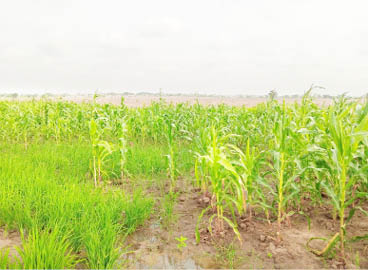How to brainstorm a successful business system for your farm
All new business endeavors should start with a good brainstorming session. By working with the people who know your existing farm or business, you can create exciting new means of income and production! You should start by sitting down (along with your spouse and any partners, financiers or managers) and assessing your situation. Have a […]

Dry season maize harvest still on going in Benue
All new business endeavors should start with a good brainstorming session. By working with the people who know your existing farm or business, you can create exciting new means of income and production!
You should start by sitting down (along with your spouse and any partners, financiers or managers) and assessing your situation. Have a brainstorming session; write down your thoughts or record the session. Don’t be afraid to dream, to imagine some pretty wild ideas. Think big. Imagine you could do anything; don’t be limited by practicality at this stage. Think of goals. Try to fill needs or supply possible markets. Think of new ways to use a resource you already have—like corn cobs. Can corn cobs be made into toys—or paper—or alcohol? Combine elements from widely different sources.
Get additional ideas from what others are doing and from published resources, such as Acres U.S.A. and Mother Earth News. Watch for new and developing trends, such as public concerns about saturated fats, or growing biofuels.
Get realistic
After you have brainstormed for ideas, then it is time to be more realistic. What are your short-term and long-term goals and needs? Just for supplementary income or to start a whole new business? Do you want steady year-round income or will a seasonal operation meet your needs? Go through your ideas and pick out several that seem the most promising.
- Why grain prices rose again, days after falling in Saminaka market
- Shettima to launch initiative to create 2,000 jobs in Gombe
Can corn cobs be turned into toys?
For each idea, take a sheet of paper and write the idea at the top, like Raising Llamas. Then write down why you want to do it, such as, “To provide a popular and unusual animal for an expanding market,” or perhaps, “To develop a new market for llama milk.”
Next, you really have to get practical. You need to do your homework and investigate the feasibility of your idea. Evaluate the pluses and minuses of your present situation. Find out what you will need to get started—and to grow bigger. Using our example:
- How much land do you need to raise llamas?
- Will llamas do well in your climate?
- What do llamas eat, anyway? Can you grow it?
- Do llamas need special housing?
- How many hours per day are required to care for a llama?
- How promising is the market for llamas? For llama milk?
- How much can you expect to pay for a llama?
- Etcetera, etcetera.
Naturally, you would like to make a profit right away, but many ventures will have sizeable start-up costs and/or may not get into the black for several years, such as growing tree fruit or pulpwood. Can you round up the needed capital—from loans, grants or investors? Check into the possibility of grants or matching funds from state or federal agencies or from private foundations. What is the likely cash-flow?
Check out the possible legal requirements or pitfalls, such as zoning laws, food safety laws, pollution control ordinances, and tax laws. Is insurance required?
Talk to potential markets to be sure they would buy your product and for how much. Do they have any quantity or quality requirements? Check out any transportation costs. Will you need to advertise; if so, which media are best and what will it cost?
Make out a detailed (as best you can) business plan and projected budget—for each year for five or ten years. If this is too much for you to handle, there are professional small business advisers available. Some government agencies provide their service at no cost.
Now, do you still want to try that idea? Is it a wise, practical idea? Think about it for a while. Discuss it with your family and others whose opinion you trust. Could your new venture survive an unexpected disaster such as illness or injury, or a devastating storm? Don’t rush into anything. Probably it would be best to start small and see how things go. Don’t risk everything at once.
Maybe “Larry’s Llama Milk” is an idea whose time has not yet come.
SUGGESTIONS
Following are some pointers from the book How to Make $100,000 Farming 25 Acres by Booker T. Whatley (1987):
- Produce only what your customers want.
- Produce high-value commodities (plants or animals) in such a way that different ones are ready to market at different times of year, thus providing year-round income and employment. Diversify into unusual products.
- Be located on a hard-surfaced road within 40 miles of an urban center of at least 50,000 population.
- Run a pick-your-own operation, so that much of the labor is done by the customer.
- Have a guaranteed market with a clientele membership club with an annual membership fee (community-supported agriculture).
- Be weatherproof, with drip and/or sprinkler irrigation.
- Avoid middlemen. Market your products directly.
- Be covered by at least $250,000 of liability insurance ($1 million is better).
Source: Foundations of Natural Farming
